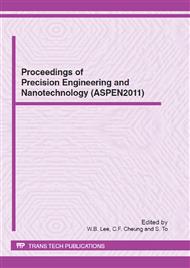p.408
p.414
p.420
p.426
p.431
p.437
p.443
p.447
p.452
Lubricated Friction Reduction by Spiral-Groove-Shape Nano-Texturing
Abstract:
To effectively reduce the friction in machines operating under lubrication, the sliding surfaces should be fully fluid-film lubricated. Under the full fluid-film lubricated conditions, the upper surface is completely supported by the lubrication film formed in the gap between the surfaces, resulting in low friction and no wear. Surface texuturing is a promising way to modify the tribological properties of sliding surfaces, and a technique for fabricating surface textures with a nanometre-order depth using a femtosecond laser can be used to easily and quickly produce periodic grooves in metal surfaces. It can thus be applied to industrial sliding surfaces to improve their tribological properties. The purpose of the study is to verify the effect of surface nanotextures fabricated using a femtosecond laser to reduce friction under lubrication. As a result, the two disks continued to operate under full fluid-film lubricated conditions even when the bearing clearance became quite small, less than 200 nm. Our testing showed that grooves with a nanometre-order depth can support a higher load than ones with a micrometre-order depth, and we proved that nanotexture can expand the full-lubricated condition.
Info:
Periodical:
Pages:
431-436
Citation:
Online since:
June 2012
Keywords:
Price:
Сopyright:
© 2012 Trans Tech Publications Ltd. All Rights Reserved
Share:
Citation:


